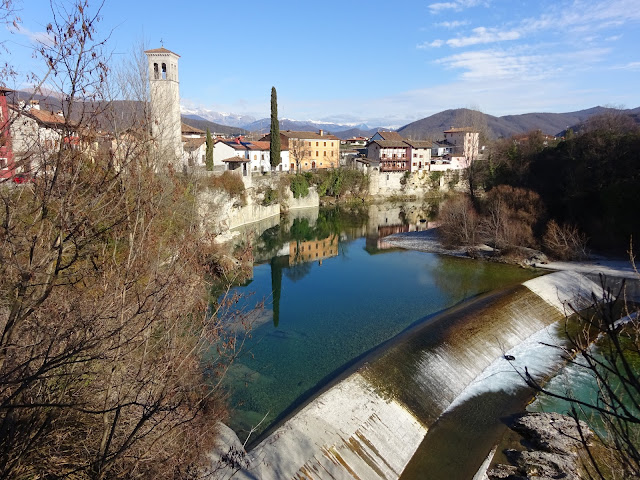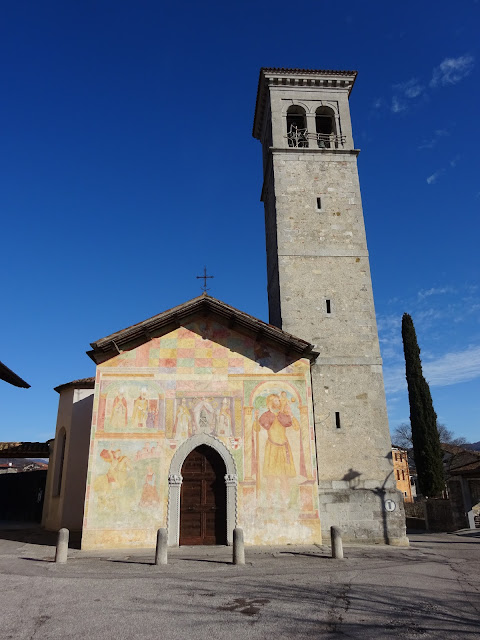 |
| Cividale del Friuli, Natisone river |
Cividale del Friuli, located in the territory of the Natisone valleys, close to the Slovenian border, is one of the most interesting and magical villages to visit in Friuli-Venezia-Giulia. Founded in the I century BC by Julius Caesar, it later became the first capital of the Lombard duchy in Italy and then Civitas Austriae with the Franks. Eventually, it saw the hegemony of the Patriarchate and then the Venetian dominion.
This historical and cultural mix makes it a real jewel and walking along its streets is like taking a journey through time.
Its most famous attraction is without any doubt, the Longobard temple, a World Heritage Site since 2011. It is a unique structure, a stone chapel built in the 1700s and used until 1893 as an oratory of the Monastery of Santa Maria in Valle.
The first glance is breathtaking: a tall and narrow chapel, topped by a stone arch decorated with openwork tracery and the large statues of saints and martyrs, while the ceiling and walls bear traces of frescoes dating from the 11th and 14th centuries.
 |
| Longobard temple, Cividale del Friuli |
 |
| Longobard temple, Cividale del Friuli |
 |
| Longobard temple, Cividale del Friuli |
The center of Cividale can be easily visited on foot, after leaving your car in one of the parking lots just outside the village., and offers plenty of legends, history and culture.
 |
| Cividale del Friuli, medieval alleys |
 |
| Cividale del Friuli, medieval alleys |
The main square is dominated by the Duomo, built in 1457 and remodeled in the following centuries. Next to the cathedral, with an entrance fee of 4 euros, you can visit the Christian Museum, housing some of the most precious testimonies of the Lombard domination.
The Palazzo dei Provveditori Veneti also overlooks the square, and houses the National Archaeological Museum. World Heritage Site, the museum stands on the remains of the Medieval Patriarchal Palace and houses an excellent collection of Roman, Lombard and Byzantine remains.
On a little square behind the museum is the delightful church of San Biagio characterized by a beautiful frescoed facade.
The Palazzo dei Provveditori Veneti also overlooks the square, and houses the National Archaeological Museum. World Heritage Site, the museum stands on the remains of the Medieval Patriarchal Palace and houses an excellent collection of Roman, Lombard and Byzantine remains.
On a little square behind the museum is the delightful church of San Biagio characterized by a beautiful frescoed facade.
 |
| San Biagio church, Cividale del Friuli |
At one end of Cividale, is the Devil's Bridge, one of the city symbols. From here you can enjoy a splendid view of the Natisone River, but my advice is to go down and look at the bridge from the opposite perspective to capture its majesty and the beautiful mix of colours and reflections created with the river.
Legend has it that the people of Cividale had asked for the Devil's help in the construction. The Devil accepted the request but asked to have the soul of the first living creature who crossed the bridge in exchange. The people agreed but, after the construction, which took place in a single night, they mocked the Devil by having an animal crossing the bridge.
 |
| The Devil's Bridge, Cividale del Friuli |
 |
| Celtic Hypogeum, Cividale del Friuli |
 |
| Celtic Hypogeum, Cividale del Friuli |
Last, but bot least, don't miss the elegant Piazza Diacono; surrounded by fine Venetian-style buildings and centered by the statue of Paolo Diacono, the Longobard historian, who died in the 8th century. This is where the weekly market takes place on Saturday and it is the perfect place to stop for an aperitif!
 |
| Piazza Diacono, Cividale del Friuli |
TIPS AND INFO:
1. The tourist office is located on the Piazza Diacono and offers plenty of info and leaflets regarding the city and the surrounding areas.
2. Every fourth Sunday of the month, an antiques market, called "Il Baule del Diavolo" takes place in town
3. All wine lovers should associate the visit of Cividale with an exploration of the Collio Goriziano area.
4. Anyone visiting Cividale in winter should taste the delicious Gubana cake a traditional recipe of the Christmas holidays.



0 Yorumlar